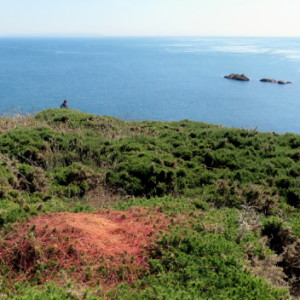Devil's Guts
Strangleweed, Fairy Hair, Hellbind, Red Tangle and Adder's Cotton are some of the names that have been given to this parasitic plant better known as Dodder.
It's not common and, on hearing it was present in the county, I was determined to find it at long last. This involved a strenuous walk around the craggy southernmost coastline of Pembrokeshire on a hot day - and what a day! A cloudless sky, flowers everywhere, butterflies abounding, ladybirds on the wing, cormorants and choughs patrolling the cliffs, the deep blue of the sea wrinkling with underwater currents while across the sound the dark undulating silhouette of Ramsey Island basked like a whale. The further off shapes of the Bishops and Clerks shimmered in the heat haze.
Well, we almost gave up and then I spotted a sort of coppery mat lying across the gorse [see extra]. That was it! On close examination it was easy to see the ruby threads criss-crossing each other in a dense tangle with small waxy pink flowers strung along them. The filaments were tacky like part-cooked linguine and impossible to separate or pull away. Devil's Net, Hairy Bind - all these names are descriptive of the sinister clinging quality of this strange growth that literally siphons its nourishment from its victims' stems, as, doing away with its own roots, it spreads its wiry network from plant to plant.
The 17th century description of Dodder in John Pechey's Compleat Herbal conveys the plant's evil reputation:
This fawning Parasite, and ungrateful Guest, hugs the Herb it hangs upon, with its long Threads and reddish Twigs; and so closely embraces it that at length it defrauds the hospitable Herb of its Nourishment, and destroys it by its treacherous Embraces.
Dodder remains a serious agricultural pest today when it attacks crops such as beans, peas and tomatoes. Here on the coast it infests only gorse of which there is no shortage. However, recent research in China has highlighted the possibility of putting dodder's communication skills to good use. It's already known that all plants can communicate to alert others of their kind to impending danger (such as an attack by a pest) giving time for its neighbours to manufacture protective toxins. Dodder, by 'wiring together' several members of the same (and different!) plant species, can transmit alarm signals in as little as half an hour and over 10 metres or more. Potentially, the manipulation of dodder genes could give food plants the ability to mobilize their own speedy defences without the need for chemical pesticides.
Or it could leave us all enveloped in the strangling, sucking red threads of Hellbind, Witch's Hair, Wizard's Net - the 5G of the plant world?
That's for the future anyway. As for me I will dodder happily into my dotage now that I have at last seen Dodder.
Wikipedia


Comments
Sign in or get an account to comment.


